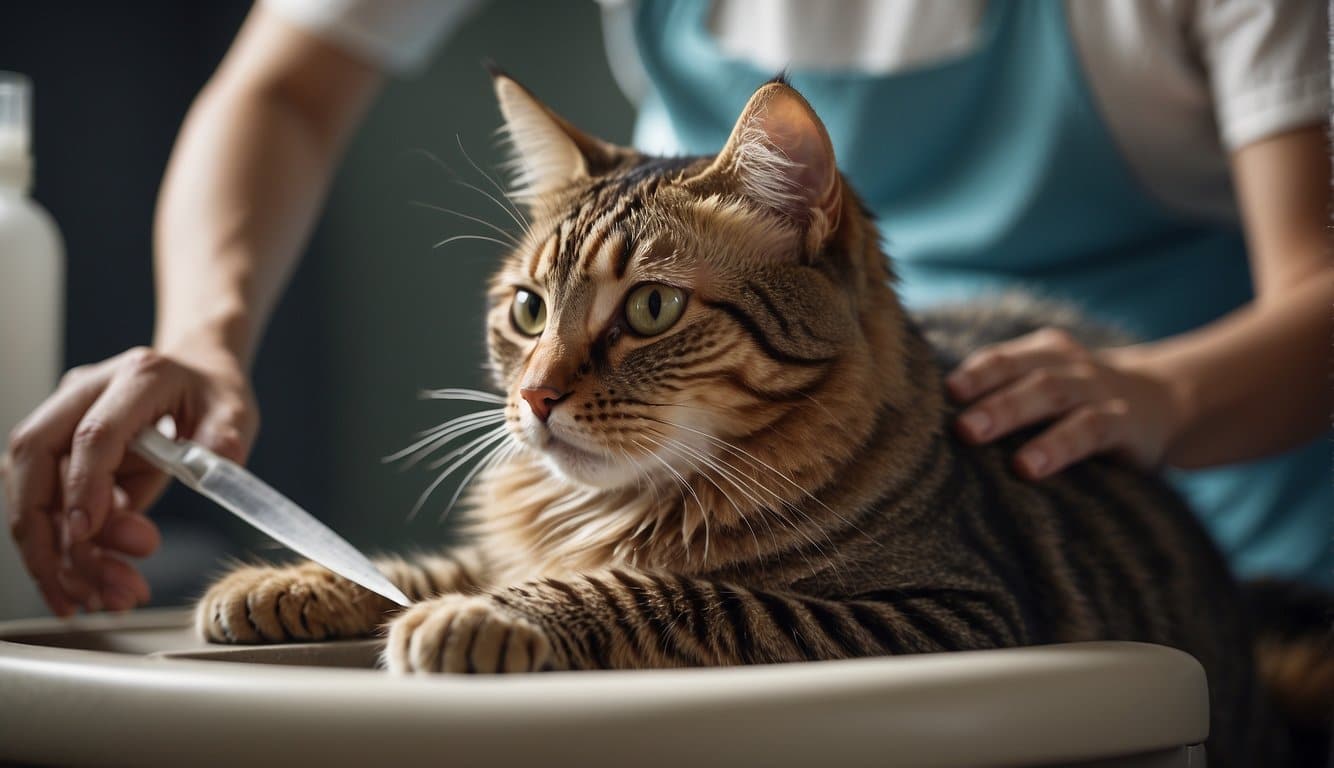Getting Rid of Fleas on Cats: A Winning Strategy
Step 1: Confirm Flea Infestation
- Question: Have you seen fleas or flea dirt (tiny black specks) on your cat?
- Yes: Proceed to Step 2.
- No: Continue regular grooming and monitoring.
Step 2: Choose a Flea Treatment
- Action: Select an appropriate flea treatment.
- Options:
- Topical Treatments: Apply a vet-recommended topical solution monthly.
- Oral Flea Medications: Administer a flea control pill as prescribed by your vet.
- Flea Collars: Fit your cat with a flea collar that repels and kills fleas.
- Consultation: Always consult your veterinarian before starting any flea treatment to ensure it’s safe and suitable for your cat’s age, weight, and health.
- Options:
Step 3: Apply Treatment
- Action: Properly apply or administer the flea treatment.
- Topical Solutions: Part the fur and apply directly to the skin, usually at the base of the neck or along the spine.
- Oral Medications: Follow dosing instructions provided by your vet.
- Flea Collars: Adjust the collar to fit your cat’s neck without being too tight; generally, you should be able to fit two fingers under the collar.
Step 4: Treat the Environment
- Action: Eliminate fleas from your home to prevent reinfestation.
- Indoor Cleaning:
- Vacuum: Regularly vacuum floors, furniture, and areas where your cat spends time.
- Wash Bedding: Wash all pet and household bedding in hot water weekly.
- Flea Sprays: Use flea home spray as directed, focusing on carpets, furniture, and beneath furniture.
- Outdoor Control:
- Lawn Care: Keep your lawn trimmed and free from debris. Consider using nematodes or flea control sprays that are safe for outdoor use.
- Indoor Cleaning:
Step 5: Continuous Flea Control
- Action: Maintain a regular flea control regimen.
- Regular Treatments: Continue applying or administering flea control products as recommended by your veterinarian.
- Monitoring: Regularly check your cat for fleas, especially during the warm months.
Step 6: Consult Your Veterinarian
- Question: Are fleas still a problem after treatment?
- Yes: Consult your veterinarian for further advice. There may be a need for different treatments or a more integrated pest management approach.
- No: Continue with preventative measures.
Additional Tips
- Avoid Flea Baths: Cats generally do not need flea baths; topical or oral treatments along with environmental control are usually sufficient.
- Natural Remedies Caution: Be cautious with natural remedies and essential oils; many are toxic to cats.
Flea Identification on Your Feline Friend
Identifying fleas on your beloved cat can be like a sneaky game of hide-and-seek, only this one’s for keeps. Gear up, intrepid pet detective, because you’re on the prowl for:
- The Adult Flea: These pesky invaders are small, about a pinhead to an eighth of an inch max, and sport a dark reddish-brown color.
- Flipping through your cat’s fur, you might spot these fast-moving critters leaping out of sight.
Look for the Signs:
- Flea Dirt: It’s the polite term for flea feces. If you find tiny brown-black specks on your cat’s skin or bedding, it’s a signpost saying “Fleas live here!”
- Itchy Cat Alert: Is your furball scratching like it’s trying to beat a world record?
- Skin irritation or hair loss, especially around the lower back and base of the tail, often means flea activity.
Flea Detective Tools:
- Flea Comb: Your go-to gadget to unravel this mystery. Stroke it through the fur and gather evidence on a white paper towel.
- Moisture Test: Dab those suspicious specs with a damp paper towel.
- Reddish smears? That’s the flea dirt giving up its secrets – yes, your kittie has fleas!
Top Methods to Treat Fleas on Cats
When your cat’s got fleas, it’s all about swift and effective action. From vet-approved solutions to natural alternatives and even professional help, here’s how you can reclaim your feline friend’s comfort.
Flea Medication Options
- Spot-On Treatments: Apply these topical solutions directly to your cat’s skin. They’re designed for easy use and long-lasting protection against fleas.
- Oral Medications: Grab fast-acting pills that start killing fleas in 30 minutes, offering your cat quick relief.
- Flea Collars: These can provide continuous flea prevention, and the newer types can be both safe and effective.
Natural Remedies for Flea Removal
- Diatomaceous Earth: This natural powder can be used to dehydrate and kill fleas in your home.
- Essential Oils: While you must be cautious due to potential toxicity to cats, carefully selected oils like rosemary and cumin can repel fleas.
- Regular Grooming: Comb your cat with a fine-toothed flea comb to physically remove fleas and flea dirt.
Professional Extermination Services
- Home Treatments: Hire professionals for a full home extermination. They can treat your space to eliminate fleas at every life stage.
- Follow-Up: Ensure you schedule a follow-up to prevent future infestations; pros can help you keep your home flea-free for the long term.
Preventative Measures to Keep Fleas at Bay
Fleas: those pesky little critters that can turn your feline friend’s life into a scratchy nightmare! But don’t fret, with a few proactive steps, you can keep your kitty’s coat as spotless as a leopard’s.
Let’s dive in with some fur-tastic tips to prevent fleas from setting up a flea circus on your pet.
Regular Flea Treatments:
- Stick to a schedule with monthly flea preventative treatments. Topicals or oral medications – chat with your vet to find the purr-fect one.
In the Home:
- Wash! Get all your cat’s bedding, your bedding, and any fabrics your furball lounges on into the washer regularly, hot cycle please.
- Vacuum like you’re on a treasure hunt, paying special attention to carpets, furniture, and all nooks and crannies.
| Environment | Action |
|---|---|
| Indoors | Vacuum and wash bedding frequently. |
| Outdoors | Keep your garden tidy – mow that lawn, trim hedges, and clear clutter. |
Grooming is Key:
- Comb your cat’s fur with a flea comb. Daily. Seriously, it’s like a spa day, every day.
- Bathing: While most cats are not fans of water, a gentle bath with a cat-safe flea shampoo can work wonders!
Don’t Forget The Other Critters:
If you’re a multi-pet household, treat all your pets, not just the feline members. Fleas don’t discriminate – they’ll hitch a ride on anyone!
Cleaning Routines for Flea Control
Creating a flea-free environment involves two key aspects: methodical home cleaning and thorough cat grooming. These work hand-in-hand to effectively combat flea infestations.
Home Cleaning Strategies
- Vacuuming: Regularly vacuum carpets, furniture, and any nooks where fleas could hide. Ensure to:
- Dispose of vacuum bags promptly to prevent fleas from escaping.
- Clean bagless vacuums with hot water to kill any remaining fleas.
- Laundry: Wash your cat’s bedding, your bedding, and any fabric covers in hot water at least once a week to kill fleas and eggs.
- Floors and Surfaces: Mop hard surfaces with a flea-killing solution or hot water, especially in places where your cat frequently visits.
Cat Grooming Techniques
- Flea Combs: Use a flea comb to catch and remove fleas and their eggs from your cat’s fur, and then dip the comb in hot, soapy water to kill any fleas on it.
- Bathing: Wash your cat with a flea shampoo or gentle soap periodically. It’s a direct way to kill fleas if your cat tolerates bathing—just be careful of their eyes and ears.
Recognizing and Addressing Flea-Related Health Issues
Hey there, cat lovers! Let’s tackle those pesky health issues that fleas can cause for your furry friends. When fleas hop on for a ride, they’re not just annoying—they can whip up some real trouble. Keep an eye out and be ready to spring into action.
Spot the Signs
- Itchy Business: Yours kitties may scratch more than a DJ if fleas are throwing a party in their fur. Be on alert for excessive scratching, biting, or licking.
- Flea Dirt: This looks like tiny black dots on your cat’s skin or bedding, which are actually flea feces.
- Red Patches & Hair Loss: Irritated skin and patchy fur can mean that fleas have been dining on your cat.
First Aid for Feline Flea Troubles:
- Flea Comb A Go-Go: Grab a flea comb and do a meticulous search-and-rescue for those unwelcome guests. Comb especially after a bath.
- Spot-On Treatments: Ask your vet about medications. Applying these can knock out fleas and prevent future invasions.
- Medicated Baths: Sometimes a medicated bath is the ticket to soothe irritated skin and evict fleas.
Frequently Asked Questions
Tackling a flea infestation on your cat can be a puzzling endeavor, but these FAQs are sure to guide you toward providing comfort and safety to your feline friend quickly and effectively.
What home remedies can I apply to my cat for flea treatment?
You may try combing your cat with a fine-tooth flea comb to remove fleas and then bathing them with a mild soap. Some swear by natural ingredients like apple cider vinegar added to the bathwater, as it’s believed fleas dislike its taste and smell.
What is the fastest method to relieve my cat of flea infestation?
The quickest way to combat fleas is to use an oral flea medication that starts killing adult fleas within 30 minutes. Meanwhile, topical treatments can start working within 24 hours.
How can I tackle fleas in my home to protect my cat?
To keep your home flea-free, vacuum all carpets and furnishings where your cat usually hangs out.
Also, regularly wash your cat’s bedding in hot water. Consider using a household flea spray or fogging your home if the infestation is significant.
Can I use over-the-counter solutions to treat my cat’s flea problem?
Yes, over-the-counter flea treatments including topical applications, collars, and sprays can be effective.
However, it’s essential to select products specifically designed for cats and always follow the manufacturer’s instructions.
What steps should I take if I discover fleas on my indoor cat?
Finding fleas on an indoor cat means you’ll need to treat both your pet and your home.
Start with a flea comb and bath. Then, treat your cat with a vet-approved flea medicine.
Don’t forget to clean your home thoroughly to eliminate any lurking fleas or eggs.
Is it possible for fleas to simply disappear from my cat without treatment?
Fleas are persistent and unlikely to disappear without proper treatment.
They can quickly multiply and infest your home, so it’s crucial to take immediate action if you spot fleas on your cat.
Last update on 2025-03-31 / Affiliate links / Images from Amazon Product Advertising API






